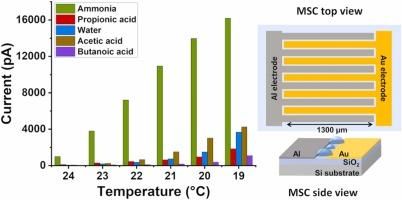使用温控电流传感器芯片直接监测单个氨或挥发性脂肪酸
IF 3.7
1区 化学
Q1 CHEMISTRY, ANALYTICAL
引用次数: 0
摘要
厌氧过程中氨(NH3)和挥发性脂肪酸(VFAs)的检测在牲畜及其废物管理以及沼气生产中起着重要作用。一种新开发的湿度传感器芯片(MSC)用于监测这些气体从水溶液中挥发出来。NH3、乙酸(AA)、丙酸(PA)和丁酸(BA)的浓度在60-150 mM范围内。为了大幅提高MSC的检测灵敏度,将MSC从24℃冷却至19℃。由于温度降低,挥发的水和溶质在MSC表面凝结,形成微滴,检测电流增加到几千皮安。检测电流也随VFAs浓度的增加而增大,且对气相中VFAs的pH条件和分压高度敏感。NH3的适用浓度范围为0 ~ 150 mM, VFAs的适用浓度范围为60 ~ 150 mM。在22°C时,传感器对NH3的最高灵敏度为12.3 mM-1。在19°C时,VFAs中AA的最高传感器灵敏度为4.0 mM-1。随着水溶液pH的增加,MSC表面形成的水滴数量按NH3>;water>;VFAs的顺序依次增加。液滴的形成顺序优先为AA>;PA>;BA,说明VFA的烷基链较短。本文提出的温控MSC适用于碱性条件下NH3的检测和酸性条件下VFAs的检测。本文章由计算机程序翻译,如有差异,请以英文原文为准。

Direct monitoring of individual ammonia or volatile fatty acids using a temperature-controlled galvanic sensor chip
The detection of ammonia (NH3) and volatile fatty acids (VFAs) during anaerobic processes plays an important role in the management of livestock and their waste, as well as in biogas production. A newly developed moisture sensor chip (MSC) was used to monitor these gasses volatized from aqueous solutions. The concentrations of NH3, acetic acid (AA), propionic acid (PA), and butyric acid (BA) were in the range 60–150 mM. To substantially improve the detection sensitivity, MSC was cooled from 24 to 19 °C. Because the temperature was decreased, volatized water and solute condensed on the surface of the MSC and the formed microdroplets and the detection current increased to several thousand picoamperes. The detection current also increased with increasing concentration of VFAs and was highly sensitive to the pH conditions and the partial pressure of VFAs in the air phase. The applicable concentration range was from 0 to 150 mM for NH3 and from 60 to 150 mM for VFAs. The highest sensor sensitivity to NH3 was 12.3 mM−1 at 22 °C. The highest sensor sensitivity for AA among VFAs was 4.0 mM−1 at 19 °C. The amount of water droplets formed on the surface of MSC increased with increasing pH of the aqueous solution in the order NH3>water>VFAs. Droplet formation preferentially occurred in the order AA>PA>BA, indicating that a shorter alkyl chain of VFA was preferred. The proposed temperature-controlled MSC is applicable for the detection of NH3 under basic conditions and for the detection of VFAs under acidic conditions.
求助全文
通过发布文献求助,成功后即可免费获取论文全文。
去求助
来源期刊

Sensors and Actuators B: Chemical
工程技术-电化学
CiteScore
14.60
自引率
11.90%
发文量
1776
审稿时长
3.2 months
期刊介绍:
Sensors & Actuators, B: Chemical is an international journal focused on the research and development of chemical transducers. It covers chemical sensors and biosensors, chemical actuators, and analytical microsystems. The journal is interdisciplinary, aiming to publish original works showcasing substantial advancements beyond the current state of the art in these fields, with practical applicability to solving meaningful analytical problems. Review articles are accepted by invitation from an Editor of the journal.
 求助内容:
求助内容: 应助结果提醒方式:
应助结果提醒方式:


